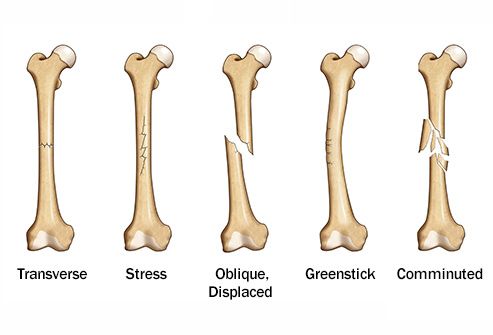What are types of fractures? These fracture subtypes can present in children and adults: A comminuted fracture is when the bone breaks into several pieces. A transverse fracture is when the fracture line is perpendicular to the shaft (long part) of the bone. You develop this type of fracture in joints that you use too often.
It is an overuse injury and is more common in athletes, ballet dancers, runners, and basketball players. Among the many different types of fractures, this type of fracture occurs when your bone breaks into two parts in a way that the bone loses its alignment. Below is a listing of the common types that may occur: Greenstick - Incomplete fracture. The broken bone is not completely separated. Oblique - Diagonal break.
Comminuted fracture - the bone is shattered into many pieces. Compression (crush) fracture - generally occurs in the spongy bone in the spine. Surgery is required in most cases to realign the bones and set them back in place with screws, pins or rods. Greenstick fractures are breaks in bones along only one side of the bone caused by a force perpendicular to the bone’s long axis. However, there are types of fractures are caused by insignificant trauma.
There may be several reasons for this. Fractures resulting from trivial trauma because the bone is weak, are called insufficient fractures. Osteoporosis, an age-related loss of bone mineral and microarchitectural change in bone. The time frame for healing depends upon the type of fracture and its location.
X-rays may be used to help determine when it is time for the cast to be removed. Finger and hand fractures may be more complicated. The hand is a complex web of tendons, blood vessels, and nerves that allow fine motor function. Common types of fractures include: Stable fracture. Open, compound fracture.

The bone may or may not be visible in the wound. Foot fracture Lisfranc fracture – in which one or all of the metatarsals are displaced from the tarsus. Jones fracture – a fracture of the proximal end of the fifth metatarsal. March fracture – a fracture of the distal third of one of the metatarsals occurring because of recurrent stress.
This is the type of fracture that occurs when an injury causes the bone to break clean, with its parts in alignment. This means that the bone maintains its original position. This typically occurs when a blow transmits a large amount of force directly perpendicular to the bone. In terms of mechanics, however, the two major types of fractures are stress fractures and compression fractures. Here’s an overview, with a little more emphasis on compression fractures, since they are far more common in older individuals with osteopenia and osteoporosis.
The location of the fracture is defined according to the location of the bone in which it occurs, proximal, middle or distal. Radius fracture Also known as distal radius fracture , it occurs when the radius, proximal to the carpal region, suffers a lesion. A fracture involving the neck of the femur.
No comments:
Post a Comment
Note: Only a member of this blog may post a comment.